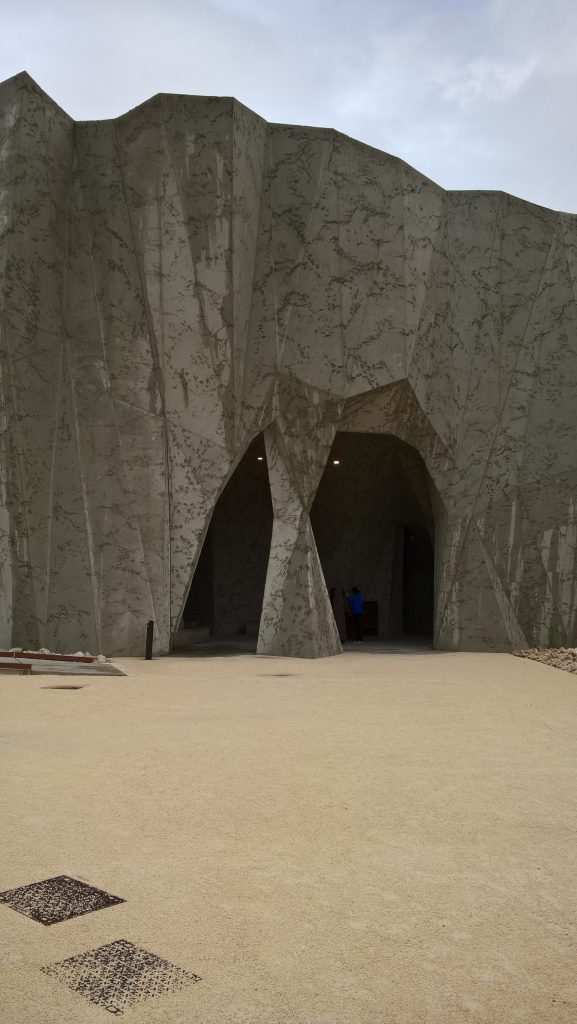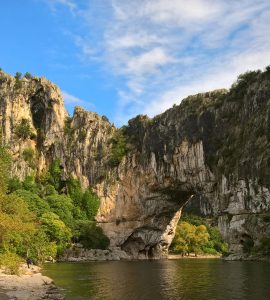
The original Chauvet cave near the small town of Vallon Pont d’Arc in the Ardeche region of France was discovered on 18th December 1994 by three cavers, Eliette Brunel-Deschamps, Christian Hillaire, and Jean-Marie Chauvet. The cave is one of the most important prehistoric art sites in the world and it was granted World Heritage status in 2014. Chauvet contains some of the most stunning images in cave art, with superbly drawn panels featuring horses, cave lions and a host of other creatures. Hundreds of drawings have been recorded, including 13 different species as well as hand stencils and other symbols.
Radio carbon dating shows that the cave had two distinct periods of habitation, one from 37,000 to 33,500 years ago and the second from 31,000 to 28,000 years ago with most of the black drawings dating to the earlier period. A child’s footprints and some ancient hearths are believed to date to the latter.

Access to the original cave has always been severely restricted for conservation reasons, but to bring the paintings to a much wider audience, a replica of the cave has been constructed and the Pont d’Arc Cavern opened to the public on 25th April 2015. Some years ago, Graham Mullan and I were fortunate enough to receive an invitation to visit the original cave, and so when the opportunity arose to take a trip over to the Ardeche, we were very keen to see the replica and compare the two experiences.
The Pont d’Arc Cavern is situated on the top of a hill overlooking the town of Vallon; it’s set in several hectares of natural woodland, with commanding views over the whole area. The replica was opened by President Hollande and in its first year attracted in the region of 600,000 visitors, far exceeding the original expectations. The cave is housed in an enormous circular building set amidst a complex consisting of the reception building and shop, interpretation spaces, educational workshops, woodland walks and a restaurant. The towering building in which the replica is housed successfully evokes the high limestone crags that characterise the Ardeche gorge and provides a fitting home for an absolute masterpiece of construction and design. The replica has a surface area of 3,000 square metres, compared to the 8,500 square metres of the original cave but despite that, all the main panels of the cave have been cleverly fitted together with the interior of the cave and its decorated panels being reproduced to the accuracy of the nearest millimetre.
The construction process involved obtaining a 3D scan of the cave to create the multi-dimensional images needed, and up to 6,000 digital images were taken, which were then superimposed on the computerised models of the cave walls. The cave consists of 130 km of handmade metal rods, 14,000 hangers for fixing and stabilizing the replica, 8,200 square metres of sculpted backdrop for the floor surface, walls and ceiling, representing 52 different types of rock, 27 decorated panels, which in turn represent 250 square metres of decorated cave wall, 300 square metres of re-created geological elements as well as 550 moulded and animal bones. Two teams of artists, headed by artist and prehistorian, Gilles Toscello and Alain Dalis worked to bring the drawings to life. The total cost was in the region of 55 million euros.
We deliberately arrived at the Pont d’Arc cave on a cloudy morning, as we had our dogs with us and there is no shade in the carpark, so bear that in mind if you’re travelling with animals. Tickets can be booked online on the website and you are advised to arrive at the site 30 minutes before your booked time to give you time to check in and walk to the building in which the replica is housed. The tickets are 13 euros for adults and 6.50 euros for ages 10 – 17. Children under 10 are admitted for free. No dogs, except guide dogs are allowed in the cave. Photos are not permitted in the cave. Two and a half hours are suggested for the visit as a whole, but it wouldn’t be difficult to spend at least three hours there, so for preference allow a half day, to give you plenty of time on site. In July and August, you can even return again in the evening on the same ticket for an unguided tour, which would suit anyone wanting to spend longer studying the art.

Each guided tour will contain up to 25 people and obviously in high season and school holidays, groups will easily reach the maximum, so for a quieter visit, out of season is a good option. A metal walkway, like the one in the original cave but much wider, runs through the replica, providing ten observation points by the various panels. The guide’s commentary is delivered to the visitor via radio headsets, which allows several tours to be in the cave at once without guides and visitors shouting to make themselves heard. The visit pauses at each of the main panels in the cave and, having seen the original, I can testify to the absolutely stunning job that the creators and artists have done. Standing in front of the horse panel, with its naturalistic representation of movement and life, evoked the same emotional response that Jean Clottes, one of the foremost experts in prehistoric art and the first scientific directors of the Chauvet cave, summed up when he said: “When I saw the panel of horses for the first time, I felt the strongest emotion of my entire life. There was nothing scientific in that feeling. I realized that I was standing in front of an extremely great work of art.”

The recreation of one of the world’s greatest art sites is so faithful that the stalactites and stalagmites even have the same sparkle as that found in the original cave. If I’d been taken in, blindfolded, and placed in front of the horse panel, and then asked whether I was in the original or the replica, I would only have been able to answer that question by reference to the walkway under my feet. The Pont d’Arc Cave looks and feels real. I was furious with a Guardian reviewer’s dismissal of the replica as a ‘fake’. It’s not. It doesn’t pretend to be the original cave. What it does is make the art in the original cave available to anyone who wants to see and experience it. Yes, there are some differences, as the creators have worked within the constraints of space, but it has all been so cleverly constructed that the only time I was actually aware of a difference was when I saw the famous eagle owl on my left in one of the alcoves and the image jumped vividly to mind of walking underneath the owl in the original cave, and then turning around to see the owl doing exactly the same thing, facing me having turned his head right around to look at me over his closed wings.
Having reached the end of the tour, I would have happily gone right back in and seen it all again. It hasn’t over-written my memories of the original cave, but it’s allowed me to experience the art for a second time and to re-live the memories of one of the most exceptional caving trips of my life.

As well as the cave, visitors are given an introduction to life in the ice age in the Aurignacian Gallery, which houses 600 square metres of panoramic mural paintings set in a permanent exhibition space devoted to life-like recreations of the animals that roamed the area 36,000 years ago, at the time of the cave paintings. My only, very minor, gripe is that, as usual, the interactive screens rarely lived up to their promise but that’s a problem common to most museums.

While you’re in the area, take the time to visit the impressive natural arch over the Ardeche river that gives the cave its name, and enjoy the stunning views up and down the gorge, but beware of the ever-present problem of thefts from cars and don’t leave any bags or other items on display. The area is heaving with tourists in the summer season, but May and June are equally beautiful, as are September and October. There are plenty of other impressive caves to visit as well, including Aven d’Orgnac, and your Chauvet entrance ticket will bring you a reduction in the entrance price. The cave is open all year round, and there are plenty of budget hotels in the nearby town of Aubenas, as well as hotels in Vallon itself.
The website is very informative and we found the booking system easy to use. There is also a link to the official site for the original cave.
27th August 2020 article updated as the Pont d’Arc web site has changed.

Correspondent: Linda Wilson
